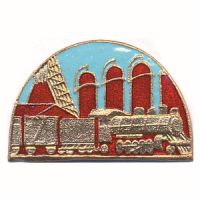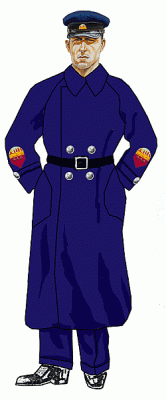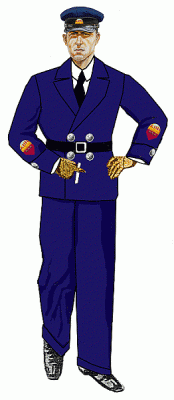USSR Industrial railway transport 1936-1943
Uniforms and insignia
Industrial transport is a production transport of industrial enterprises that carries out the movement of objects and products of labor in the field of production. On the one hand, industrial transport is an integral part of production, and on the other hand, it is the most important link in public transport.
Industrial railway transport in Russia, according to established practice, includes non-public railway transport and technological railway transport of organizations.
Non-public railway transport is a set of production and technological complexes, including non-public railway tracks, buildings, structures, structures, in some cases railway rolling stock, as well as other property; and intended to meet the needs of individuals and legal entities in works (services) in non-public places on the basis of contracts or for their own needs.
Non-public railway tracks - railway sidings adjacent directly or through other railway sidings to public railway tracks; and intended to serve certain users of railway transport services on the terms of contracts or to perform work for their own needs.
Technological railway transport - railway transport of organizations intended for the movement of goods in the territories of these organizations; and to perform initial and final operations with railway rolling stock for the own needs of these organizations.
With the development of railway transport in the USSR, railway transport of industrial enterprises also developed. Organizationally, it was under the jurisdiction and subordination of the Supreme Council of National Economy, which made it difficult to manage
Since the establishment of the People's Commissariat of Heavy Industry, great importance has been attached to the management of railway transport of enterprises.
In connection with this order of the NKTP of the USSR of June 7, 1936 No. 967, the "Charter on the Discipline of Workers and Employees of the Railway Transport of the USSR" was extended to industrial railway transport in all branches of industry subordinate to the NKTP.
In Article 15 of Chapter 3 of this Charter, employees of the operational branches of railway transport (operation, traction, track and communications) in the performance of official duties were required to be dressed strictly in the prescribed form.
On the basis of this article, the People's Commissariat of Heavy Industry develops uniforms, which are sent for consideration to the commission of the Presidium of the Central Executive Committee of the USSR for the approval of uniforms in civil People's Commissariats and organizations, where they are considered and approved on November 4, 1936.
On December 8, 1936, by order No. 1966, the People's Commissariat of Heavy Industry approved the following uniform:
1. For privates and junior commanding personnel:
a) double-breasted raglan coat, closed (hook closure) with a belt. The belt is black leather, with a white shiny metal buckle, below the belt and above the belt there are two metal buttons;
b) a tunic for the winter time made of blue cloth of the army cut and for the summer time a tunic of the same cut and color, but made of cotton fabric. In the summer, a white tunic was allowed as a non-wearable uniform.
C) breeches made of dark blue cloth for winter time and dark blue cotton fabric for summer.
commanding staff (middle and higher):
(a) A raglan coat of the same pattern and colour as for the rank and file, but of improved material; for winter time as a non-wearable uniform - a leather coat with a fur collar;
b) for winter time, a jacket made of blue cloth is open with a black leather belt with a white metal buckle, with four buttons of the same metal as the buckle, in summer the jacket was sewn from light woolen fabric. The jacket was supposed to wear a white shirt with a dark tie.
c) trousers of English cut (with cuffs at the bottom) made of dark blue cloth or light woolen fabric;
d) as a non-wearable uniform, the commanding staff was allowed to wear white trousers and a white tunic with a turn-down collar in the summer.
The headdress for the winter was a hat of dark blue cloth, trimmed with brown fur, and an army-cut cap, dark blue with a black leather patent visor and a chin strap. For the commanding staff, the cap was sewn from cloth, for the private - from cotton fabric. In summer - a white cap.
The sign for the headdress was the emblem of the department, which is an image of a gilded train moving past blast furnaces and crimson cowpers located on a blue background.
To distinguish the commanding staff by position, sleeve flaps with insignia and the emblem of the department were introduced. Sleeve insignia were sewn on both sleeves below the elbow. In the upper part of the valve, the emblem of the department was sewn, and in the lower part - a field of color according to the type of service (blue - for locomotive and wagon services, yellow for communication, green - for the track and crimson - for operational), on which the insignia of the posts were attached, which are metal, red-enameled corners, hexagons and stars
This uniform lasted until 1943, when uniforms and insignia of general railway transport were extended to workers in industrial railway transport. This principle exists to this day.
Industrial railway transport of USSR 1936-1943 rank insignia
| author | Leonid Tokar |
|---|---|
| illustrator | Leonid Tokar |
| source | www.vedomstva-uniforma.ru/mundir6/pghdt/index.html |
- Date of last modification:





